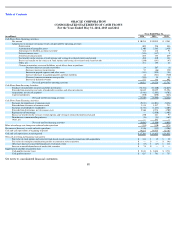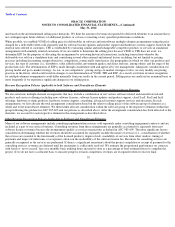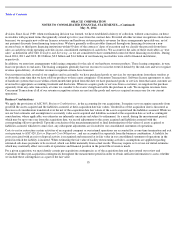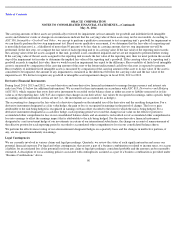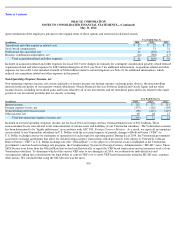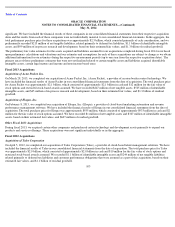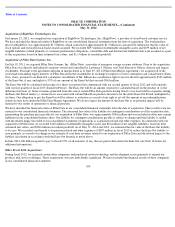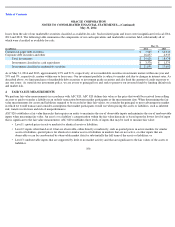Oracle 2013 Annual Report Download - page 102
Download and view the complete annual report
Please find page 102 of the 2013 Oracle annual report below. You can navigate through the pages in the report by either clicking on the pages listed below, or by using the keyword search tool below to find specific information within the annual report.
Table of Contents
ORACLE CORPORATION
NOTES TO CONSOLIDATED FINANCIAL STATEMENTS—(Continued)
May 31, 2014
The carrying amounts of these assets are periodically reviewed for impairment (at least annually for goodwill and indefinite lived intangible
assets) and whenever events or changes in circumstances indicate that the carrying value of these assets may not be recoverable. According to
ASC 350, Intangibles—Goodwill and Other , we can opt to perform a qualitative assessment to test a reporting unit’
s goodwill for impairment or
we can directly perform the two step impairment test. Based on our qualitative assessment, if we determine that the fair value of a reporting unit
is more likely than not (i.e., a likelihood of more than 50 percent) to be less than its carrying amount, the two step impairment test will be
performed. In the first step, we compare the fair value of each reporting unit to its carrying value. If the fair value of the reporting unit exceeds
the carrying value of the net assets assigned to that unit, goodwill is not considered impaired and we are not required to perform further testing.
If the carrying value of the net assets assigned to the reporting unit exceeds the fair value of the reporting unit, then we must perform the second
step of the impairment test in order to determine the implied fair value of the reporting unit’s goodwill. If the carrying value of a reporting unit’s
goodwill exceeds its implied fair value, then we would record an impairment loss equal to the difference. Recoverability of finite lived intangible
assets is measured by comparison of the carrying amount of the asset to the future undiscounted cash flows the asset is expected to generate.
Recoverability of indefinite lived intangible assets is measured by comparison of the carrying amount of the asset to its fair value. If the asset is
considered to be impaired, the amount of any impairment is measured as the difference between the carrying value and the fair value of the
impaired asset. We did not recognize any goodwill or intangible asset impairment charges in fiscal 2014, 2013 or 2012.
Derivative Financial Instruments
During fiscal 2014, 2013 and 2012, we used derivative and non-derivative financial instruments to manage foreign currency and interest rate
risks (see Note 11 below for additional information). We account for these instruments in accordance with ASC 815, Derivatives and Hedging
(ASC 815), which requires that every derivative instrument be recorded on the balance sheet as either an asset or liability measured at its fair
value as of the reporting date. ASC 815 also requires that changes in our derivatives’ fair values be recognized in earnings, unless specific hedge
accounting and documentation criteria are met (i.e., the instruments are accounted for as hedges).
The accounting for changes in the fair value of a derivative depends on the intended use of the derivative and the resulting designation. For a
derivative instrument designated as a fair value hedge, the gain or loss is recognized in earnings in the period of change. The loss or gain
attributable to the risk being hedged is recognized in earnings with an offset recorded to the item for which the risk is being hedged. For a
derivative instrument designated as a cash flow hedge, each reporting period we record the change in fair value on the effective portion to
accumulated other comprehensive loss in our consolidated balance sheets and an amount is reclassified out of accumulated other comprehensive
loss into earnings to offset the earnings impact that is attributable to the risk being hedged. For the non-derivative financial instrument
designated as a net investment hedge of our investments in certain of our international subsidiaries, the change on account of remeasurement of
the effective portion for each reporting period is recorded to accumulated other comprehensive loss in our consolidated balance sheets.
We perform the effectiveness testing of our aforementioned designated hedges on a quarterly basis and the changes in ineffective portions, if
any, are recognized immediately in earnings.
Legal Contingencies
We are currently involved in various claims and legal proceedings. Quarterly, we review the status of each significant matter and assess our
potential financial exposure. For legal and other contingencies that are not a part of a business combination or related to income taxes, we accrue
a liability for an estimated loss if the potential loss from any claim or legal proceeding is considered probable and the amount can be reasonably
estimated. A description of our accounting policies associated with contingencies assumed as a part of a business combination is provided under
“Business Combinations” above.
98


